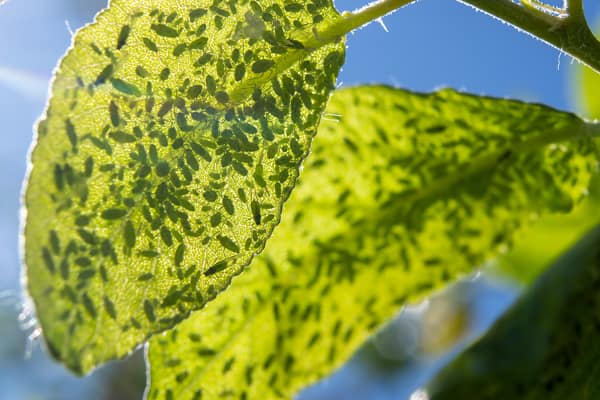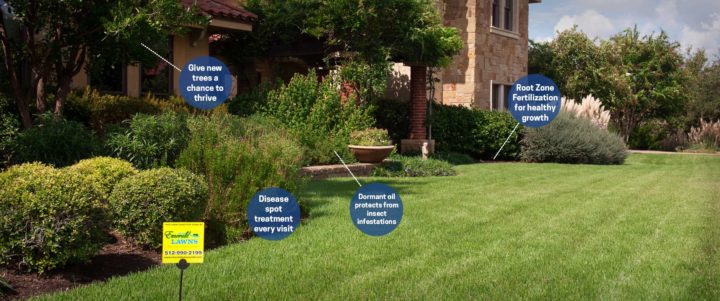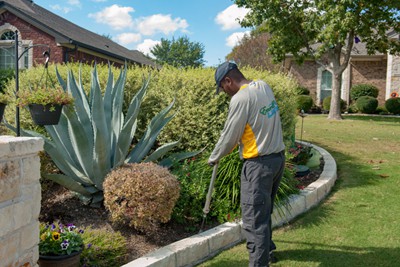Did you know Top Choice offers a tree and shrub fertilizer program? Like our lawn fertilization services, we partner with the experts over at Emerald Lawns to keep your trees, bushes, shrubs, and plants looking their best year-round!
To answer your questions about tree and shrub fertilizer, we had a chat with Yvette Judd from Emerald Lawns.
What’s the number one problem for Central Texas trees and shrubs?
Aphids! They don’t just eat leaves; they also secret a sugary substance that creates black sooty mold on trees like crepe myrtles. If you see something like dewdrops on your crepe myrtle, that’s not water; it’s aphid poop (yuck!)

We also have boring insects (yawn) that cause tiny holes in redbuds and other trees and webworms in the springtime. White bark scale is another problem we see pretty often.
How do fertilization and pest control help?
Trees and shrubs are living systems, and just like the human body, they need proper nutrients and medications to stay healthy. We’re building the landscape’s immune system. When you’re healthy, you’re able to resist disease better.
People are usually concerned with their lawns first – it’s easy to see weeds — but remember that landscaping is a lot more expensive to replace. Pest and disease are the number one cause of decline in a landscape.

Your program uses systemic pesticides. How do they work?
Our concoction treats both disease and pests. Part of that happens on contact, and part of it is systemic. We inject the treatment into the ground near the roots of the trees, where it absorbs throughout the entire organism. It’s like a shot for the trees. We’re using selective herbicides that only affect some things but not others. They are entirely safe for your tree, and systemic solutions are better than spraying the same concoction all over your lawn.
Which trees and shrubs need fertilizer?
We treat new landscaping, especially non-native trees and shrubs — they need the most help! You don’t need to treat trees over 25 feet tall or native oaks and cedars that have been on your property for some time. Those are already well adjusted and suited to your environment.
Remember that it’s easy to be reactive, but lawn care should be proactive. Our program helps your landscape even in the winter. Your plants aren’t dead, they are just dormant, and they need love then too. If you want your landscape to last a long time, you have to take care of it.

What are some common misconceptions you hear about fertilization?
Often, the confusion isn’t about fertilizer or pest control. It’s about everything else. We say that lawn care is a 50/50 partnership with our customers. Your part is important too. Improper tree and shrub care will stress your plants, making them more vulnerable to disease and pests.
- Don’t prune more than you have to. Pruning your trees and shrubs too much will send them into shock!
- Cover with cloth, not plastic, in the winter.
- Practice proper watering. Plants have different watering needs, and it’s often tricky when people have native and non-natives right together. Overwatering is worse than underwatering.
- Mow your grass to the proper height. St Augustine needs at least three inches in the sun and four in the shade. Anything less can overstress your grass.
What about Oak Wilt? Is that a disease we can prevent?
Oak wilt is a systemic virus carried by a beetle that is attracted to the pheromones in oak sap. The best defense against Oak Wilt is proper pruning, not pesticides. Don’t prune from February through June. Wait until the weather is colder when the sap flows less freely and the beetles aren’t as active. Always disinfect your tools and use pruning spray.
How does pricing work for your tree and shrub fertilizer program?
It all depends on how many and how large. We’ll count the trees and shrubs in your yard to calculate your monthly total.
Interested in a tree and shrub fertilizer program?
Contact us for a fast, free quote, and we’ll get you set up!

